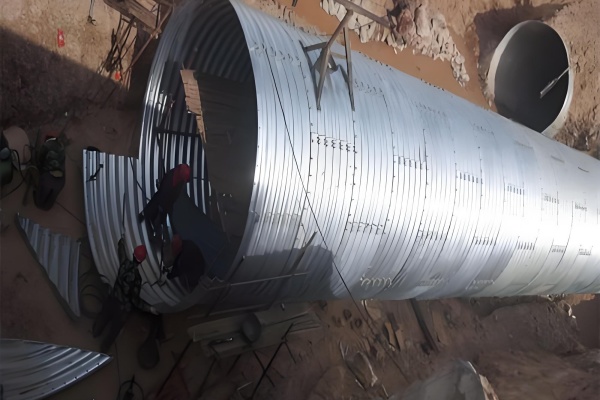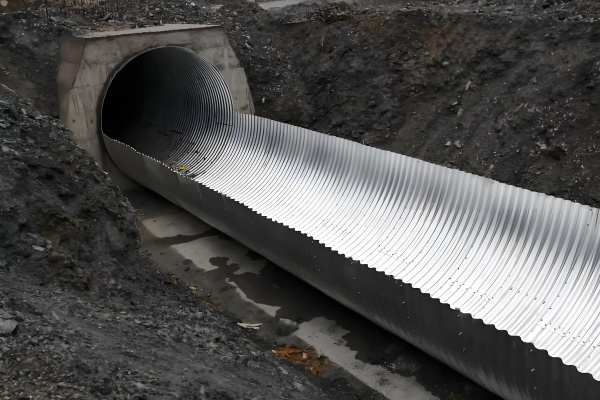Corrugated Metal Culvert Liners Reinforced Box Culverts: A Case Analysis of RWC570 Rural Road Upgrade Project
This research investigates the structural stability of corrugated steel pipe culverts reinforced with liners, focusing on the RWC570 rural road upgrade and maintenance project. The study examines the stress distribution, displacement, and circumferential strain of box culverts reinforced with different liner materials. Key findings reveal that under two-point loading, corrugated steel pipe liners demonstrate superior deformation resistance compared to circular steel pipe liners when reinforcing reinforced concrete box culverts. Controlling deformation and crack width is critical to ensuring long-term safety and durability. Corrugated liner-reinforced culverts exhibit enhanced bending resistance and deformation capacity, significantly improving service life and structural reliability.
In infrastructure, culverts are vital for overcoming terrain challenges, with corrugated metal culverts widely adopted due to their simplicity, cost-effectiveness, and ease of installation. Research on liner-reinforced corrugated steel pipe culverts enhances structural stability, seismic resilience, and longevity. Previous studies by scholars such as Zhang Zhen highlight reinforcement techniques—including steel concrete, basalt fibers, and polymers—that markedly improve strength and stiffness. Gong Yafeng's plastic analysis further confirms that liner reinforcement boosts load-bearing capacity, reduces localized deformation, and minimizes deflection
This study, grounded in the RWC570 project in Bomet County, Kenya (230km west of Nairobi), evaluates mechanical performance under varying reinforcement methods. The region experiences distinct seasonal rainfall patterns (heavy rains April-May, light rains November-December), emphasizing the culvert’s critical drainage role. By integrating physical and structural mechanics principles, this work provides actionable technical guidance for optimizing corrugated steel pipe culvert reinforcement, ensuring cost-effective and durable rural road infrastructure solutions.
This study proposes a reinforcement method for box culverts using corrugated metal culvert liners to improve structural performance. Two steel pipe box culvert designs were developed based on corrugated pipe dimensions, liner material properties, and infill characteristics. Both designs exhibit high strength and stiffness, effectively resisting large external loads and deformation.
To optimize stiffness and crack resistance, C30 concrete was selected as the liner material, prefabricated with a 200mm-thick structure featuring an arched top and flat base. Steel mesh reinforcement was embedded within the liner to enhance tensile strength and ductility. Results demonstrate that reinforced concrete box culverts with internal liners achieve significant improvements in load-bearing capacity, stiffness, and deformation resistance. Comparative analysis of circular steel pipe liners versus corrugated steel pipe culverts reveals distinct advantages: circular liners enhance ultimate load capacity, stiffness, and deformation tolerance, while corrugated liners provide superior initial stiffness and secant stiffness. However, corrugated liners exhibit lower ductility, increasing susceptibility to brittle failure. Thus, material selection must prioritize engineering-specific requirements for balanced performance.
In the RWC570 rural road drainage upgrade project (Bomet County, Kenya), stress distribution, displacement, and circumferential strain of liner-reinforced culverts were systematically analyzed. Key findings include:
1.Under two-point loading, unreinforced concrete culverts show significantly greater vertical deformation than horizontal deformation. Shear distortion at loading points exacerbates vertical displacement.
2.Corrugated steel pipe liners effectively reduce tensile strain on both inner and outer surfaces of concrete culverts, outperforming circular pipe liners. This is attributed to the corrugated profile, which enhances bonding with concrete and distributes stress more uniformly.
While current practices align with TCECSG:D66-01-2019, two areas require prioritized study.Performance validation: Quantifying the efficacy of expansion joints in corrugated steel culverts under long-term settlement.Material optimization: Testing hybrid joint designs
Expansion devices have been installed at the connection points between steel corrugated pipes and large concrete structures such as reservoirs and dissipation pools, as well as at locations where the rock types of the foundation strata are inconsistent, and at excavation and backfilling boundaries. However, due to the limited use of expansion devices in similar projects, there is a lack of research on the effectiveness of steel corrugated pipe expansion devices. The next step will be to further study the anti settlement performance of different expansion devices.ubber-bitumen composites, HDPE sleeves) to enhance deformation compatibility.
The waterproofing of assembled corrugated metal culverts primarily relies on segment installation methods and sealing materials. In previous applications, the waterproof structure of these culverts adopted a lap-joint design. The assembly involves overlapping two corrugated steel plates and connecting them with bolts. During this process, gaps between plates, bolt holes penetrating the plates, and spaces between bolts and holes become potential leakage points.
The main leakage occurs at circumferential lap joints. This is primarily caused by uneven settlement in flexible foundations within months after backfilling. Such settlement stretches or compresses the lap joints, displacing bolts from their original positions and misaligning sealing materials, ultimately creating leakage paths.
The outward-flanged flange process integrates the flange with corrugated steel culvert plates as a single unit, featuring a 70mm-high flange. Plates are bolted without penetrating the inner/outer walls of the corrugated structure, transforming circumferential connections into a single linear leakage path (eliminating point leaks). Even under compression or tension, bolts remain fixed within holes, preventing displacement.
In this project, outward-flanged flanges connect corrugated steel culvert sections. Additional sealing measures are applied:
Seal strips and adhesive at joints between sections, couplings, flanges, and overlapping plates. An external waterproof layer using self-adhesive metalized aluminum foil membrane.
3.The corrugated liner-reinforced culvert (RRCP2) demonstrates superior ultimate load capacity, initial stiffness, and secant stiffness compared to both unreinforced and circular liner-reinforced designs.
These results validate that corrugated steel pipe culverts significantly enhance resistance to pressure, bending, and shear forces, offering a robust solution for extending infrastructure lifespan in seasonal flood-prone regions. The methodology provides actionable insights for optimizing liner materials and geometries in similar engineering contexts.
 Products
Products Application
Application



